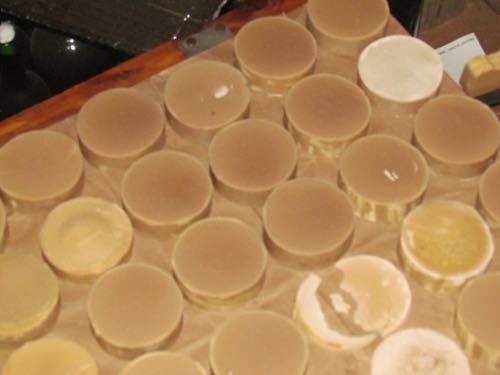Aly and I experimented with a new soap “flavor” recently. Time will tell how successful we were, but at the moment, we see reasons to hope!
Those reasons came after way too many doubts. Aly wanted to try making spruce soap. I’ve had experience with spruce soap from other, more professional soap producers in Southeast Alaska. Unlike the Christmas tree aroma one might expect, spruce soap is citrusy, like the spruce honey and wine that we make here (see Sprucing Up). Aly led the charge, but we all wanted to try it.
Unfortunately, other priorities intervened during spruce tip harvest season. I managed to pick some tips, and made a tea from them, which ended up in the cool box, all but forgotten. When the time came to make soap, we found it unspoiled, and proceeded.
Ideally, we would have steeped the tips in the oils we intended to use for the soap. Instead, we used the tea as water in which to dissolve the lye.
(At this point, I’d like to apologize to those readers who don’t make soap! Some of this post will only interest those who do, or aspire to make soap. Feel free to skip to the next paragraph if the discussion becomes too technical.)
This caused concern, as we tried to figure out what, exactly, creates the “spruceness” of the tips. Is it the pollen? Or, is it the tree’s oils—oil, as in that which chemically reacts with lye to saponify!
When we mixed the lye and the tea, we immediately got a liquid that resembled a dark beer. It even had foam on top!
Luckily, only Aly and I worked on the soap that day. So, our reaction to this unexpected result was, basically: “Cool!”
We did question what might happen next. More so when, upon turning on the mixer to combine the (intended) oils and the lye, we smelled not spruce pollen, but . . . fish.
We still haven’t figured out what that was about. We have, however, learned that the fishy smell did not come from the soap mixture!
That left us to anticipate the resulting color of the soap. Admittedly, we don’t try to color our soaps, being happy with the natural tints of the various varieties. Even so, the prospect of a darker soap excited us. The next day, when we popped the soap out molds and sliced it into cakes, the color had lightened some, but still, we had a darker product than we are used to. And, it smelled like spruce. Maybe not as much as we’d like, but enough like spruce, and unlike fish, that it’ll do for a first try.
Only time will tell if this darker color will survive the curing process. I expect that the soap will lighten further as it cures, but if we’re lucky, we’ll end up with this darker shade. Will it appeal to those who buy our soap on line or at our local distributor in Haines? It’s hard to say. But, we make soap for ourselves, not just for sale. I know as a family, we’re going to get a kick out of the new color, even if no one else does.


I love your soap! It makes me feel really clean. I hoard it so it lasts as long as possible. I have made two last from Christmas until now, and have one more to last until the end of the year.
Thanks for such a lovely product!
Virginia, we’re so glad you like it! Just don’t hoard it too long–or maybe check it now and then. Vegetable-based oil soaps supposedly can go rancid. We’ve never seen that, and we usually use GSE as an additional preservative, but there’s always a chance. I assume in your drier environment, though, it’s not an issue.